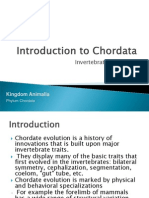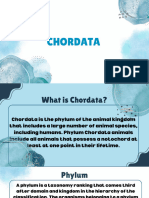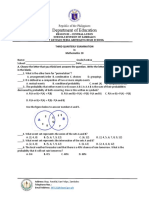0 ratings0% found this document useful (0 votes)
29 viewsPhylum Chordata Transes
Phylum Chordata Transes
Uploaded by
Maribel Ramos InterinoThe phylum Chordata contains animals that share four key characteristics: a notochord, dorsal hollow nerve cord, pharyngeal slits, and a post-anal tail. Chordates are divided into three subphyla: Cephalochordata, Urochordata, and Vertebrata. Vertebrates make up the largest group and have a cranium and closed circulatory system. They are divided into classes including fish, amphibians, reptiles, birds, and mammals.
Copyright:
© All Rights Reserved
Available Formats
Download as DOCX, PDF, TXT or read online from Scribd
Phylum Chordata Transes
Phylum Chordata Transes
Uploaded by
Maribel Ramos Interino0 ratings0% found this document useful (0 votes)
29 views2 pagesThe phylum Chordata contains animals that share four key characteristics: a notochord, dorsal hollow nerve cord, pharyngeal slits, and a post-anal tail. Chordates are divided into three subphyla: Cephalochordata, Urochordata, and Vertebrata. Vertebrates make up the largest group and have a cranium and closed circulatory system. They are divided into classes including fish, amphibians, reptiles, birds, and mammals.
Original Title
PHYLUM-CHORDATA-TRANSES
Copyright
© © All Rights Reserved
Available Formats
DOCX, PDF, TXT or read online from Scribd
Share this document
Did you find this document useful?
Is this content inappropriate?
The phylum Chordata contains animals that share four key characteristics: a notochord, dorsal hollow nerve cord, pharyngeal slits, and a post-anal tail. Chordates are divided into three subphyla: Cephalochordata, Urochordata, and Vertebrata. Vertebrates make up the largest group and have a cranium and closed circulatory system. They are divided into classes including fish, amphibians, reptiles, birds, and mammals.
Copyright:
© All Rights Reserved
Available Formats
Download as DOCX, PDF, TXT or read online from Scribd
Download as docx, pdf, or txt
0 ratings0% found this document useful (0 votes)
29 views2 pagesPhylum Chordata Transes
Phylum Chordata Transes
Uploaded by
Maribel Ramos InterinoThe phylum Chordata contains animals that share four key characteristics: a notochord, dorsal hollow nerve cord, pharyngeal slits, and a post-anal tail. Chordates are divided into three subphyla: Cephalochordata, Urochordata, and Vertebrata. Vertebrates make up the largest group and have a cranium and closed circulatory system. They are divided into classes including fish, amphibians, reptiles, birds, and mammals.
Copyright:
© All Rights Reserved
Available Formats
Download as DOCX, PDF, TXT or read online from Scribd
Download as docx, pdf, or txt
You are on page 1of 2
PHYLUM CHORDATA courting, and signaling when danger is near.
-In humans, the post-anal tail is vestigial, that
is, reduced in size and nonfunctional.
- All have gill slits that lead into the throat or
pharynx REPRODUCTION
- have blood enclosed in blood vessels, -They are sexual: meaning that an egg is
although they may not have blood cells. fertilized by a sperm.
-have a tail that contains no internal organs -few animals are asexual: without sex
and extends beyond the backbone and anus. -some fish and reptiles reproduced through
Parthenogenesis.
CHARACTERISTICS
-Most chordates are Dioecious.
-the phylum Chordata share four key feature:
But some chordates are Hermaphroditic
notochord, a dorsal hollow nerve cord,
- Terrestrial species: Internal Fertilization
pharyngeal slits, and a post-anal tail
-Aquatic Species: External Fertilization
-In some groups, some of these are present only
-Animals that develop in eggs outside their
during embryonic development.
mothers body are called Oviparous.
NOTOCHORD
- Flexible, rod-like structures SUBPHYLA OF CHORDATES
- made of cartilage that runs between an
animals digestive tube and its nerve chord. SUBPHYLUM CEPHALOCHORDATA
-In most vertebrates, a skeleton develops - Also called Acrania.
around the notochord and allows the muscles to - possess a notochord,dorsal hollows, nerve
attach. chord, pharyngeal slits and a post-anal tail.
- In humans, the notochord is reduced to the -EXTINCT MEMBER:
disks of cartilage that we have between our Pikaia- the oldest known cephalochordate.
vertebrate. -EXTANT MEMBER:
Lancelets- named for their blade-like shaped.
DORSAL HOLLOW NERVE -suspension feeders
-Hollow, tubular structure derived from
ectoderm
-Located dorsal to the notochord in chordates.
-Tube made of fibers SUBPHYLUM UROCHORDATA
-Also referred to as Tunicate or Sea Squirts.
PHARYNGEAL GILLS SLITS Tunic- tunicate derives from the cellulose-like
- openings in the pharynx, that extend to the carbohydrate material
outside environment. - they only have pharyngeal slits
- all Chordates have pharyngeal slits -hermaphroditic
-they function as filters for feeding. -live a sessile existence on the ocean floor and
are suspension feeders
POST-ANAL TAIL
-muscular, posterior elongation of the body, SUBPHYLUM VERBRATA
extending beyond the anus.
-contains -Also referred to as Craniate.
skeletal elements and muscles: provide a -A cranium is a bony, cartilaginous or fibrous
source of locomotion in aquatic species, such as structure;
fishes - and sorrounds the brain, jaw and facial bones.
-in terrestrial vertebrates, helps with balance, -Vertebrata is named for the vertebral column,
composed of vertebrae.
-Closed circulatory system.
-Vertebrates are the largest group of chordates
-Constitute classes in the subphylum Vertebrata:
Agnatha, Chondrichthyes, Osteichthyes,
Amphibia, Reptilia, Aves and Mammalia.
You might also like
- 1 Animal DiversityDocument31 pages1 Animal DiversityAnjan Tej NayakNo ratings yet
- Vertebrates (Kingdom Animalia)Document130 pagesVertebrates (Kingdom Animalia)Nurl AinaNo ratings yet
- bio-210Document14 pagesbio-210Abubakar MuhammadNo ratings yet
- A1.3b Chordata (Handout) - 2018Document3 pagesA1.3b Chordata (Handout) - 2018Wayne DayataNo ratings yet
- Lecture 06 - Cephalochordata and VertebrataDocument20 pagesLecture 06 - Cephalochordata and Vertebratamasif gondalNo ratings yet
- Notes (2023) - Classification Outline3Document15 pagesNotes (2023) - Classification Outline3subhayu589No ratings yet
- Filum ChordataDocument46 pagesFilum Chordatayohanna theresiaNo ratings yet
- Module 1 Chapters 1 and 2Document125 pagesModule 1 Chapters 1 and 2Liana Marie Castro DavidNo ratings yet
- Phylum Chordata: Dr. Muhammad ZahidDocument27 pagesPhylum Chordata: Dr. Muhammad ZahidMUHAMMAD ILYASNo ratings yet
- Comparative Vertebrate Anatomy ReviewerDocument3 pagesComparative Vertebrate Anatomy ReviewerJohn Rudolf CatalanNo ratings yet
- Family_Phylum_ChordataDocument21 pagesFamily_Phylum_ChordataEzilleyyyNo ratings yet
- Bs 2nd Lec 5Document3 pagesBs 2nd Lec 5rimshabashir950No ratings yet
- Protochordata-Characters & PhylogenyDocument4 pagesProtochordata-Characters & PhylogenyAakash V100% (1)
- Basics of Biology: Professor Vishal Trivedi Department of Biosciences and Bioengineering, IIT Guwahati, Assam, IndiaDocument32 pagesBasics of Biology: Professor Vishal Trivedi Department of Biosciences and Bioengineering, IIT Guwahati, Assam, IndiaAKKARSHANA P BIOTECH-2018 BATCHNo ratings yet
- Lower Chordata Lecture - 2023Document5 pagesLower Chordata Lecture - 2023BHEKUMUSA MASEKONo ratings yet
- Animal KingdomDocument2 pagesAnimal KingdomMark BuhainNo ratings yet
- LS10 1Pg1Document1 pageLS10 1Pg1sinned68No ratings yet
- Bio 85Document17 pagesBio 85karinadawn.remaciaNo ratings yet
- ChordatesDocument39 pagesChordatesrebeccajohnbabatundeNo ratings yet
- Invertebrates Chordata VertebratesDocument62 pagesInvertebrates Chordata VertebratesDao Ming SiNo ratings yet
- Chor DatesDocument95 pagesChor DatesKavitaNo ratings yet
- Lecture 03 - Classification of ChordatesDocument26 pagesLecture 03 - Classification of Chordatesmasif gondalNo ratings yet
- CHORDATE ZOOLOGY - Lecture 2b - ProtochordatesDocument39 pagesCHORDATE ZOOLOGY - Lecture 2b - Protochordatesassastephano7No ratings yet
- Animal Phyla Project-1 (1) SHUMDocument29 pagesAnimal Phyla Project-1 (1) SHUMGlen MangaliNo ratings yet
- Animal Kingdom Phylum Chordata Notes For NEET Download PDF - pdf-57Document8 pagesAnimal Kingdom Phylum Chordata Notes For NEET Download PDF - pdf-57Sushma MarkeNo ratings yet
- ProtochordataDocument7 pagesProtochordataricoghofarNo ratings yet
- Chapter 31.2 - Chordates: Phylum ChordataDocument4 pagesChapter 31.2 - Chordates: Phylum Chordata6gzdhsm8gsNo ratings yet
- Comparative Vertebrate AnatomyDocument3 pagesComparative Vertebrate AnatomyDaniel KangNo ratings yet
- Lecture 07 - Vertebrata - AgnathaDocument37 pagesLecture 07 - Vertebrata - Agnathamasif gondalNo ratings yet
- Phylum Chordata: (Some Invertebrates and All Vertebrates)Document60 pagesPhylum Chordata: (Some Invertebrates and All Vertebrates)nightingale1995No ratings yet
- Zoology-Laboratory ACT10 FishDocument3 pagesZoology-Laboratory ACT10 Fish88jzqz5gxrNo ratings yet
- AnimaliaDocument68 pagesAnimaliaNovelynLozano-EdrosoNo ratings yet
- Phylum ChordataDocument35 pagesPhylum ChordataHAECKEL ZAC S. MATANo ratings yet
- 29.1A Characteristics of ChordataDocument2 pages29.1A Characteristics of ChordataEirah Gabrielle RiducaNo ratings yet
- 1.diversity of Animal LifeDocument39 pages1.diversity of Animal Lifekapil Rajputpl100% (1)
- Introduction To ChordataDocument203 pagesIntroduction To ChordataYhan Brotamonte BoneoNo ratings yet
- Intro To Chordates - PPT WeeblyDocument53 pagesIntro To Chordates - PPT Weeblyapi-375285021100% (1)
- Animal Kingdom ChordataDocument10 pagesAnimal Kingdom ChordataRaichal P BijuNo ratings yet
- ChordataDocument41 pagesChordataHasna NanaNo ratings yet
- Animal Kingdom (Chordata)Document47 pagesAnimal Kingdom (Chordata)sakthishree1005No ratings yet
- GenbioDocument14 pagesGenbiokristelcline4142007No ratings yet
- 3-Characteristics of Phylum ChordataDocument5 pages3-Characteristics of Phylum Chordatasultanmehmod.bnNo ratings yet
- The ChordatesDocument6 pagesThe Chordatesfathiaseidu78No ratings yet
- Report about Chordata_by A.F.ADocument28 pagesReport about Chordata_by A.F.AE DivinagraciaNo ratings yet
- ANTOMY - Comparative AnatomyDocument4 pagesANTOMY - Comparative AnatomyMark Christian AlcantaraNo ratings yet
- Phylum Chordata & Vert IntroDocument22 pagesPhylum Chordata & Vert IntroFarman khanNo ratings yet
- Hemichordates and Chordates - M 2024Document19 pagesHemichordates and Chordates - M 2024MISRA NASILUNNo ratings yet
- Bio 3Document6 pagesBio 3loan aleNo ratings yet
- Verebrate Final Ppt-1Document127 pagesVerebrate Final Ppt-1tinseejohnNo ratings yet
- Zoology-Laboratory ACT11 AmphibiansDocument4 pagesZoology-Laboratory ACT11 Amphibians88jzqz5gxrNo ratings yet
- Comparative Anatomy - Protochordates and The Origin of CraniatesDocument16 pagesComparative Anatomy - Protochordates and The Origin of CraniatesjeannegiananNo ratings yet
- Phylum Arthropoda TransesDocument2 pagesPhylum Arthropoda TransesMaribel Ramos InterinoNo ratings yet
- External Anatomy of Vertebrates Class AgnathaDocument9 pagesExternal Anatomy of Vertebrates Class AgnathaJerico YoNo ratings yet
- VertebratesDocument8 pagesVertebratesfeya ayefNo ratings yet
- Reptila To MamDocument41 pagesReptila To MamVivek BaisNo ratings yet
- 1A ChordataDocument76 pages1A ChordataDeepak ThakurNo ratings yet
- Protochordates Write UpDocument9 pagesProtochordates Write UpKashak Parmar SinghNo ratings yet
- The Book of Shells: Containing the Classes Mollusca, Conchifera, Cirrhipeda, Annulata, and CrustaceaFrom EverandThe Book of Shells: Containing the Classes Mollusca, Conchifera, Cirrhipeda, Annulata, and CrustaceaNo ratings yet
- Parent ConsentDocument2 pagesParent ConsentMaribel Ramos InterinoNo ratings yet
- Parent ConsentDocument1 pageParent ConsentMaribel Ramos InterinoNo ratings yet
- Mathematics 8 - Tos - Quarter 1 2Document4 pagesMathematics 8 - Tos - Quarter 1 2Maribel Ramos InterinoNo ratings yet
- Work Immersion Parental ConsentDocument1 pageWork Immersion Parental ConsentMaribel Ramos InterinoNo ratings yet
- Table of Specifications: Third Periodic Test in Mathematics 10Document4 pagesTable of Specifications: Third Periodic Test in Mathematics 10Maribel Ramos InterinoNo ratings yet
- Gen, Math - DLL WK 1Document11 pagesGen, Math - DLL WK 1Maribel Ramos InterinoNo ratings yet
- CLASS PROGRAM SHS 2022-2023 RegularDocument11 pagesCLASS PROGRAM SHS 2022-2023 RegularMaribel Ramos InterinoNo ratings yet
- 3RD Quarter Examination G10Document4 pages3RD Quarter Examination G10Maribel Ramos InterinoNo ratings yet
- WaiverDocument1 pageWaiverMaribel Ramos InterinoNo ratings yet
- SHS-School-Program-1st Sem 2022-2023Document3 pagesSHS-School-Program-1st Sem 2022-2023Maribel Ramos InterinoNo ratings yet
- Table 1.1: Status of Ways Forward For The Previous Quarter: 3Rd Quarter Issues/Concerns/ Needs/GapsDocument23 pagesTable 1.1: Status of Ways Forward For The Previous Quarter: 3Rd Quarter Issues/Concerns/ Needs/GapsMaribel Ramos InterinoNo ratings yet
- G8DLL Q2W10 LC39Document14 pagesG8DLL Q2W10 LC39Maribel Ramos InterinoNo ratings yet
- Enterp 2Document5 pagesEnterp 2Maribel Ramos InterinoNo ratings yet
- Enterp 4Document4 pagesEnterp 4Maribel Ramos InterinoNo ratings yet
- TEMPLATE For HISTORICAL SOURCES 1Document11 pagesTEMPLATE For HISTORICAL SOURCES 1Maribel Ramos InterinoNo ratings yet
- Gen Math Q2 W7 QADocument20 pagesGen Math Q2 W7 QAMaribel Ramos InterinoNo ratings yet
- Phylum Echinodermata TransesDocument2 pagesPhylum Echinodermata TransesMaribel Ramos InterinoNo ratings yet
- Phylum Arthropoda TransesDocument2 pagesPhylum Arthropoda TransesMaribel Ramos InterinoNo ratings yet
- Choose The Best Word To Complete The Sentence.: Pilih Perkataan Yang Terbaik Untuk Melengkapkan Ayat BerikutDocument11 pagesChoose The Best Word To Complete The Sentence.: Pilih Perkataan Yang Terbaik Untuk Melengkapkan Ayat Berikutsaguna24No ratings yet
- Latihan Soal UH Adaptations 2425Document4 pagesLatihan Soal UH Adaptations 2425Hasna Nadia SalsabilaNo ratings yet
- Anglais OralDocument2 pagesAnglais OralCrepeyNo ratings yet
- Science Chapter 9-Chapter CheckUpDocument6 pagesScience Chapter 9-Chapter CheckUpAmy Leah MagawNo ratings yet
- Animal Behavior Practice SheetDocument5 pagesAnimal Behavior Practice SheetSelman PepeljakNo ratings yet
- ĐỀ 33Document6 pagesĐỀ 33Chi ĐỗNo ratings yet
- Data Santoso Pets 2024.Xlsx - PenjualanDocument20 pagesData Santoso Pets 2024.Xlsx - PenjualancvsantosopetNo ratings yet
- Bat Bats Are Mammals of The Order Chiroptera.: Jubatus, Which Can Weigh 1.6 KG (3Document36 pagesBat Bats Are Mammals of The Order Chiroptera.: Jubatus, Which Can Weigh 1.6 KG (3Valdomero TimoteoNo ratings yet
- Dairy Bull - 551BS01421 - Hilltop Acres D Kickstart ETDocument1 pageDairy Bull - 551BS01421 - Hilltop Acres D Kickstart ETJonasNo ratings yet
- Earthworm DissectionDocument5 pagesEarthworm Dissectionunexia.productions101No ratings yet
- TaxonamyDocument1 pageTaxonamyapi-223708047No ratings yet
- Bodily Structures of AnimalsDocument36 pagesBodily Structures of AnimalsCatherine Lagario RenanteNo ratings yet
- Homosexual Necrophilia in The MallardDocument6 pagesHomosexual Necrophilia in The MallardxuanvNo ratings yet
- Scicent SQ U3 1-2 SetA Final eDocument6 pagesScicent SQ U3 1-2 SetA Final esteve LNo ratings yet
- Watermelon - Powerpoint TemplateDocument30 pagesWatermelon - Powerpoint TemplateUlysses DeckerNo ratings yet
- Ebook Calculate With Confidence Canadian 1St Edition Morris Test Bank Full Chapter PDFDocument29 pagesEbook Calculate With Confidence Canadian 1St Edition Morris Test Bank Full Chapter PDFrowenathuyzdwqr100% (19)
- Keep404 PDFDocument7 pagesKeep404 PDFbashraaNo ratings yet
- Molly Fish:: Scientific Name Common Name Attainable Size Origin Environment Water Company Aquarium Feed BreedingDocument3 pagesMolly Fish:: Scientific Name Common Name Attainable Size Origin Environment Water Company Aquarium Feed BreedingPS PRADEEPNo ratings yet
- Biology 11 - Shark Dichotomous Key WorksheetDocument2 pagesBiology 11 - Shark Dichotomous Key WorksheetMinNo ratings yet
- GuWh ES L4 Grammar WKS U4Document2 pagesGuWh ES L4 Grammar WKS U4American ClassNo ratings yet
- Importance of MetamorphosisDocument3 pagesImportance of MetamorphosisAfrid BaigNo ratings yet
- LionDocument43 pagesLionMustafa DildarNo ratings yet
- Zoology DivisionsDocument10 pagesZoology DivisionsMatt Jerome LoveresNo ratings yet
- Animal Life Spans: CFE 3209VDocument10 pagesAnimal Life Spans: CFE 3209VShekel DeninoNo ratings yet
- Black-Tailed GodwitDocument5 pagesBlack-Tailed GodwitacademicDNo ratings yet
- Bahasa Inggris Kelas 2 2024Document4 pagesBahasa Inggris Kelas 2 2024Tasya Nadia putriNo ratings yet
- Listening - LlamasDocument2 pagesListening - LlamasRonnald Matías RojasNo ratings yet
- LPM Unit - 1 - Terminology Used in Animal HusbandryDocument20 pagesLPM Unit - 1 - Terminology Used in Animal Husbandryjoyalo740No ratings yet
- Pre-Farrowing ActivitiesDocument5 pagesPre-Farrowing Activitiesdennis jay paglinawanNo ratings yet
- Ants Play An Important Role in The EnvironmentDocument4 pagesAnts Play An Important Role in The EnvironmentIshmeet KaurNo ratings yet










































































































